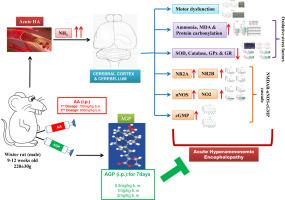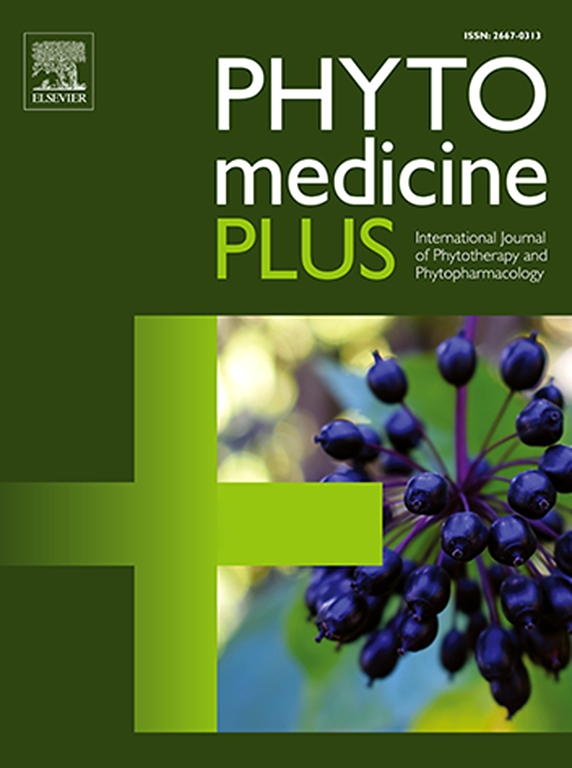穿心莲内酯可预防急性高氨血症诱发的大鼠运动功能障碍。其作用机制的证据
Q3 Pharmacology, Toxicology and Pharmaceutics
引用次数: 0
摘要
背景除了肝硬化高氨血症(HA),非肝硬化高氨血症(HA)也会导致神经变性和 "高氨血症脑病",最终导致昏迷阶段。我们对穿心莲草药的水提取物进行了试验性研究,以对抗 HA 诱导的大鼠氧化应激。穿心莲内酯(AGP)是从穿心莲中分离出来的主要成分,据报道具有多种生物活性。本研究旨在探索 AGP 对非肝硬化急性 HA 模型大鼠的治疗潜力。方法对大鼠的运动功能进行转动和牵引试验,检测脑氨和血清氨水平,以确认是否发生了急性肝损伤。研究了丙二醛(MDA)、还原型谷胱甘肽(GSH)、蛋白质羰基化水平以及超氧化物歧化酶(SOD)、过氧化氢酶、谷胱甘肽过氧化物酶(GPx)和谷胱甘肽还原酶(GR)的活性,作为氧化应激标志物。检测了大脑皮层和小脑中两个 NMDAR 亚基 NR2A、2B、nNOS 的表达以及亚硝酸盐(NO2)和 cGMP 的水平,以研究 NMDAR-nNOS-cGMP 级联。急性 HA 导致大鼠运动功能障碍,MDA 水平和蛋白质羰基化显著增加,而 SOD、过氧化氢酶、GPx 和 GR 受抑制,大脑皮层和小脑中的 NMDAR-nNOS-cGMP 级联被激活。所有这些都表明高氨血症脑病已经形成。结论:我们的研究表明,AGP 是一种潜在的天然抗高氨血症药物,它通过抑制 NMDAR-nNOS-cGMP 级联以及大脑皮层和小脑的氧化应激,防止了大鼠急性高氨血症脑病的发生。本文章由计算机程序翻译,如有差异,请以英文原文为准。

Andrographolide prevents acute hyperammonemia-induced motor dysfunction in rats. Evidences for its mechanism of action
Background
Beside the cirrhotic one, non-cirrhotic hyperammonemia (HA) can also cause neuro-degeneration and establishment of 'Hyperammonemic Encephalopathy', ultimately leading to the coma stage. We have done pilot study on aqueous extract of Andrographis paniculata herb against HA induced oxidative stress in rats. Andrographolide (AGP) is the major component isolated from of A paniculata and reported to have various biological activities.
Purpose
Present study aimed to explore the therapeutic potentiality of AGP on rat model of non cirrhotic acute HA.
Methods
Rotarod and traction test was performed to access the motor function. Brain and serum ammonia level were assayed to confirm occurrence of HA. Malondialdehyde (MDA), reduced glutathione (GSH), protein carbonylation levels and activity of superoxide dismutase (SOD), catalase, glutathione peroxidase (GPx), glutathione reductase (GR) were studied as oxidative stress markers. Expression of two NMDAR subunits, NR2A, 2B, nNOS and level of nitrite (NO2), cGMP in cerebral cortex and cerebellum were assayed to study the NMDAR-nNOS-cGMP cascade.
Result
Acute HA caused motor dysfunction in rats. MDA level and protein carbonylation, increased significantly while SOD, catalase, GPx and GR got suppressed and NMDAR-nNOS-cGMP cascade activated in cerebral cortex and cerebellum. All these suggested establishment of hyperammonemic encephalopathy. AGP treatment restored the motor function, lowered the ammonia level, suppressed the oxidative stress markers, NR2A, 2B, nNOS over-expression and elevated NO2, cGMP levels in cortex and cerebellum.
Conclusion
Our study showed AGP could be a potential natural anti-hyperammonemic drug as it has prevented the development of acute hyperammonemic encaphalopathy in rats by suppressing NMDAR-nNOS-cGMP cascade and oxidative stress in cerebral cortex and cerebellum.
求助全文
通过发布文献求助,成功后即可免费获取论文全文。
去求助
来源期刊

Phytomedicine Plus
Medicine-Complementary and Alternative Medicine
CiteScore
3.70
自引率
0.00%
发文量
178
审稿时长
81 days
期刊介绍:
 求助内容:
求助内容: 应助结果提醒方式:
应助结果提醒方式:


